Analytical Research Paper: End-of-Life Decisions and the Quinlan Case
VerifiedAdded on 2022/12/01
|8
|3864
|368
Report
AI Summary
This analytical research paper examines the Karen Ann Quinlan case, a significant legal and ethical event concerning end-of-life decisions. The paper details the facts of the case, including Quinlan's coma and her parents' fight to remove life support. It explores the court's ruling, focusing on the legal basis for the decision, particularly the right to privacy. The report analyzes the actions and beliefs of both the hospital and the parents, providing a defense for one side. It then discusses the complex end-of-life issues involved, such as autonomy, justice, and the right to die, alongside advanced directives, living wills, and powers of attorney. The paper provides definitions of these concepts to support its position, emphasizing the importance of informed decision-making and the evolving relationship between law, medicine, and patient rights. The analysis considers the impact of the case on subsequent legal and ethical frameworks, promoting the need for clearer guidelines and patient protection in end-of-life scenarios.
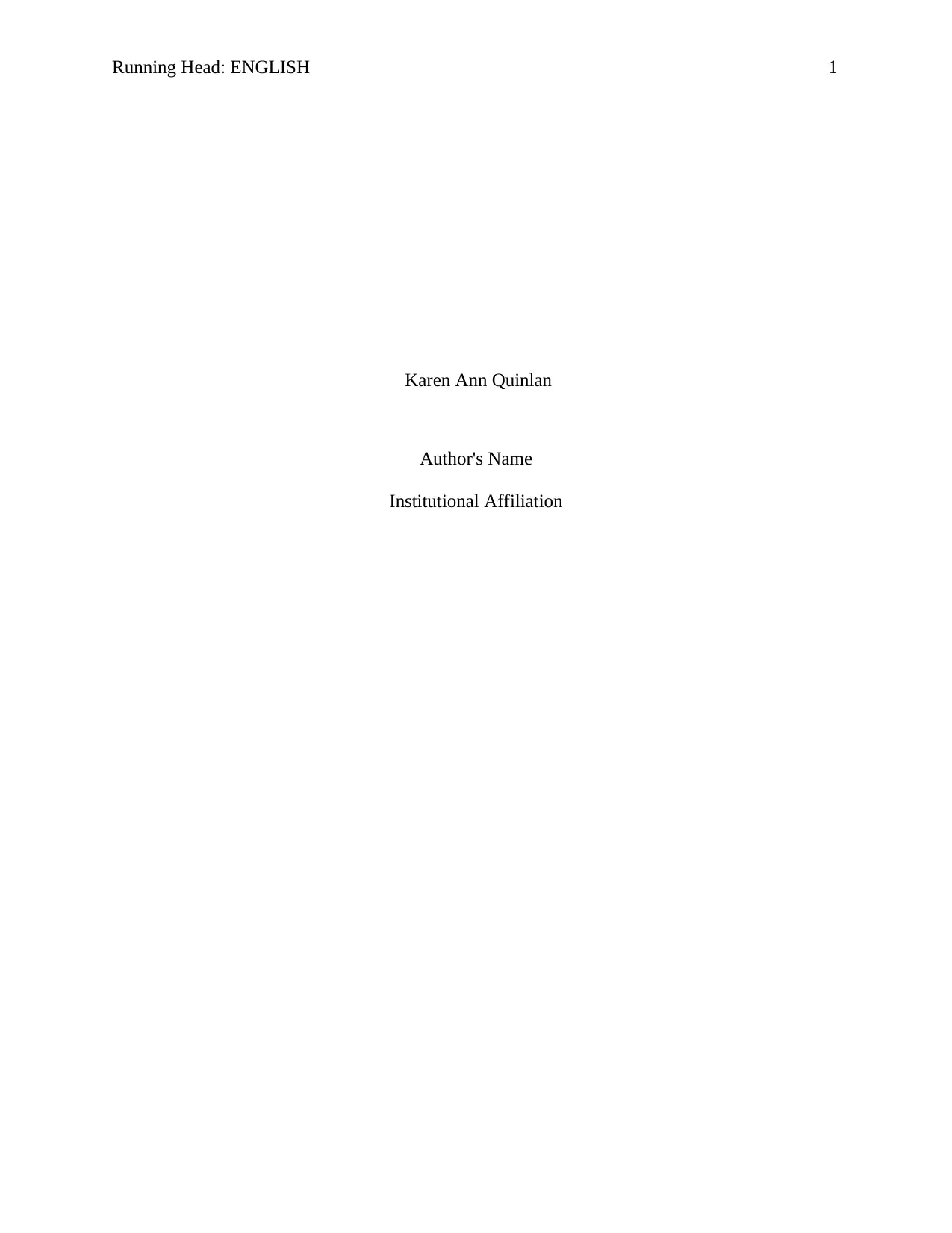
Running Head: ENGLISH 1
Karen Ann Quinlan
Author's Name
Institutional Affiliation
Karen Ann Quinlan
Author's Name
Institutional Affiliation
Paraphrase This Document
Need a fresh take? Get an instant paraphrase of this document with our AI Paraphraser
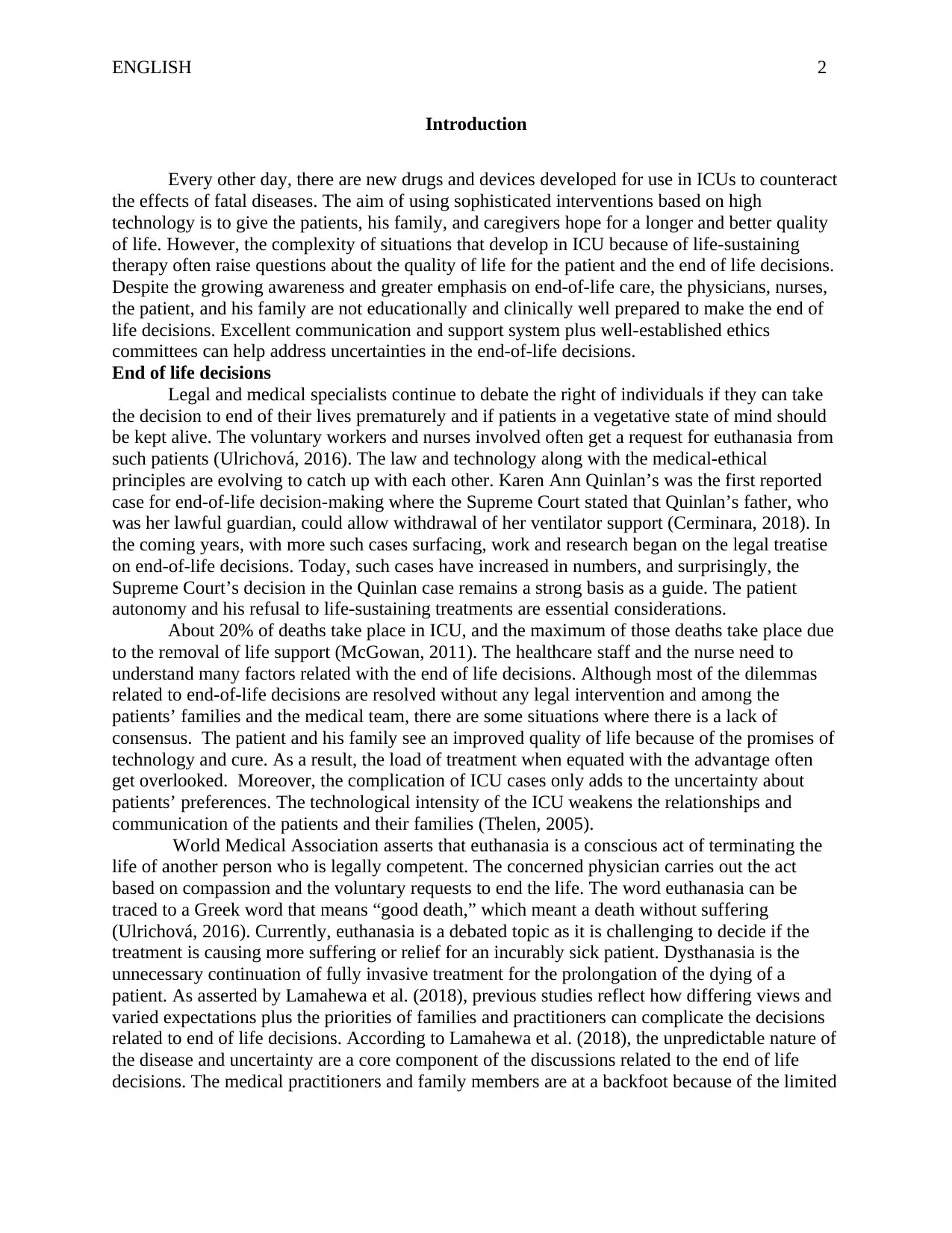
ENGLISH 2
Introduction
Every other day, there are new drugs and devices developed for use in ICUs to counteract
the effects of fatal diseases. The aim of using sophisticated interventions based on high
technology is to give the patients, his family, and caregivers hope for a longer and better quality
of life. However, the complexity of situations that develop in ICU because of life-sustaining
therapy often raise questions about the quality of life for the patient and the end of life decisions.
Despite the growing awareness and greater emphasis on end-of-life care, the physicians, nurses,
the patient, and his family are not educationally and clinically well prepared to make the end of
life decisions. Excellent communication and support system plus well-established ethics
committees can help address uncertainties in the end-of-life decisions.
End of life decisions
Legal and medical specialists continue to debate the right of individuals if they can take
the decision to end of their lives prematurely and if patients in a vegetative state of mind should
be kept alive. The voluntary workers and nurses involved often get a request for euthanasia from
such patients (Ulrichová, 2016). The law and technology along with the medical-ethical
principles are evolving to catch up with each other. Karen Ann Quinlan’s was the first reported
case for end-of-life decision-making where the Supreme Court stated that Quinlan’s father, who
was her lawful guardian, could allow withdrawal of her ventilator support (Cerminara, 2018). In
the coming years, with more such cases surfacing, work and research began on the legal treatise
on end-of-life decisions. Today, such cases have increased in numbers, and surprisingly, the
Supreme Court’s decision in the Quinlan case remains a strong basis as a guide. The patient
autonomy and his refusal to life-sustaining treatments are essential considerations.
About 20% of deaths take place in ICU, and the maximum of those deaths take place due
to the removal of life support (McGowan, 2011). The healthcare staff and the nurse need to
understand many factors related with the end of life decisions. Although most of the dilemmas
related to end-of-life decisions are resolved without any legal intervention and among the
patients’ families and the medical team, there are some situations where there is a lack of
consensus. The patient and his family see an improved quality of life because of the promises of
technology and cure. As a result, the load of treatment when equated with the advantage often
get overlooked. Moreover, the complication of ICU cases only adds to the uncertainty about
patients’ preferences. The technological intensity of the ICU weakens the relationships and
communication of the patients and their families (Thelen, 2005).
World Medical Association asserts that euthanasia is a conscious act of terminating the
life of another person who is legally competent. The concerned physician carries out the act
based on compassion and the voluntary requests to end the life. The word euthanasia can be
traced to a Greek word that means “good death,” which meant a death without suffering
(Ulrichová, 2016). Currently, euthanasia is a debated topic as it is challenging to decide if the
treatment is causing more suffering or relief for an incurably sick patient. Dysthanasia is the
unnecessary continuation of fully invasive treatment for the prolongation of the dying of a
patient. As asserted by Lamahewa et al. (2018), previous studies reflect how differing views and
varied expectations plus the priorities of families and practitioners can complicate the decisions
related to end of life decisions. According to Lamahewa et al. (2018), the unpredictable nature of
the disease and uncertainty are a core component of the discussions related to the end of life
decisions. The medical practitioners and family members are at a backfoot because of the limited
Introduction
Every other day, there are new drugs and devices developed for use in ICUs to counteract
the effects of fatal diseases. The aim of using sophisticated interventions based on high
technology is to give the patients, his family, and caregivers hope for a longer and better quality
of life. However, the complexity of situations that develop in ICU because of life-sustaining
therapy often raise questions about the quality of life for the patient and the end of life decisions.
Despite the growing awareness and greater emphasis on end-of-life care, the physicians, nurses,
the patient, and his family are not educationally and clinically well prepared to make the end of
life decisions. Excellent communication and support system plus well-established ethics
committees can help address uncertainties in the end-of-life decisions.
End of life decisions
Legal and medical specialists continue to debate the right of individuals if they can take
the decision to end of their lives prematurely and if patients in a vegetative state of mind should
be kept alive. The voluntary workers and nurses involved often get a request for euthanasia from
such patients (Ulrichová, 2016). The law and technology along with the medical-ethical
principles are evolving to catch up with each other. Karen Ann Quinlan’s was the first reported
case for end-of-life decision-making where the Supreme Court stated that Quinlan’s father, who
was her lawful guardian, could allow withdrawal of her ventilator support (Cerminara, 2018). In
the coming years, with more such cases surfacing, work and research began on the legal treatise
on end-of-life decisions. Today, such cases have increased in numbers, and surprisingly, the
Supreme Court’s decision in the Quinlan case remains a strong basis as a guide. The patient
autonomy and his refusal to life-sustaining treatments are essential considerations.
About 20% of deaths take place in ICU, and the maximum of those deaths take place due
to the removal of life support (McGowan, 2011). The healthcare staff and the nurse need to
understand many factors related with the end of life decisions. Although most of the dilemmas
related to end-of-life decisions are resolved without any legal intervention and among the
patients’ families and the medical team, there are some situations where there is a lack of
consensus. The patient and his family see an improved quality of life because of the promises of
technology and cure. As a result, the load of treatment when equated with the advantage often
get overlooked. Moreover, the complication of ICU cases only adds to the uncertainty about
patients’ preferences. The technological intensity of the ICU weakens the relationships and
communication of the patients and their families (Thelen, 2005).
World Medical Association asserts that euthanasia is a conscious act of terminating the
life of another person who is legally competent. The concerned physician carries out the act
based on compassion and the voluntary requests to end the life. The word euthanasia can be
traced to a Greek word that means “good death,” which meant a death without suffering
(Ulrichová, 2016). Currently, euthanasia is a debated topic as it is challenging to decide if the
treatment is causing more suffering or relief for an incurably sick patient. Dysthanasia is the
unnecessary continuation of fully invasive treatment for the prolongation of the dying of a
patient. As asserted by Lamahewa et al. (2018), previous studies reflect how differing views and
varied expectations plus the priorities of families and practitioners can complicate the decisions
related to end of life decisions. According to Lamahewa et al. (2018), the unpredictable nature of
the disease and uncertainty are a core component of the discussions related to the end of life
decisions. The medical practitioners and family members are at a backfoot because of the limited
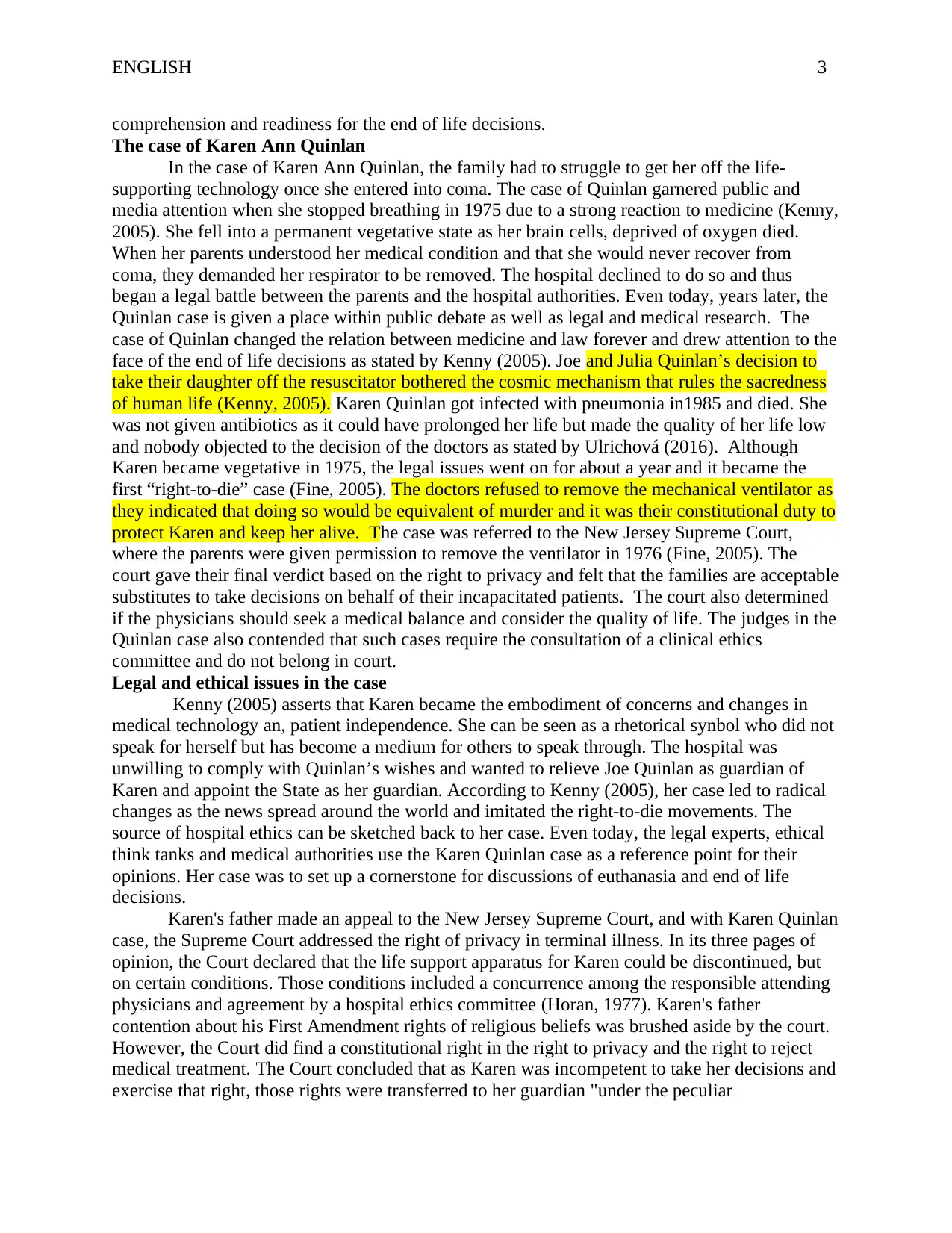
ENGLISH 3
comprehension and readiness for the end of life decisions.
The case of Karen Ann Quinlan
In the case of Karen Ann Quinlan, the family had to struggle to get her off the life-
supporting technology once she entered into coma. The case of Quinlan garnered public and
media attention when she stopped breathing in 1975 due to a strong reaction to medicine (Kenny,
2005). She fell into a permanent vegetative state as her brain cells, deprived of oxygen died.
When her parents understood her medical condition and that she would never recover from
coma, they demanded her respirator to be removed. The hospital declined to do so and thus
began a legal battle between the parents and the hospital authorities. Even today, years later, the
Quinlan case is given a place within public debate as well as legal and medical research. The
case of Quinlan changed the relation between medicine and law forever and drew attention to the
face of the end of life decisions as stated by Kenny (2005). Joe and Julia Quinlan’s decision to
take their daughter off the resuscitator bothered the cosmic mechanism that rules the sacredness
of human life (Kenny, 2005). Karen Quinlan got infected with pneumonia in1985 and died. She
was not given antibiotics as it could have prolonged her life but made the quality of her life low
and nobody objected to the decision of the doctors as stated by Ulrichová (2016). Although
Karen became vegetative in 1975, the legal issues went on for about a year and it became the
first “right-to-die” case (Fine, 2005). The doctors refused to remove the mechanical ventilator as
they indicated that doing so would be equivalent of murder and it was their constitutional duty to
protect Karen and keep her alive. The case was referred to the New Jersey Supreme Court,
where the parents were given permission to remove the ventilator in 1976 (Fine, 2005). The
court gave their final verdict based on the right to privacy and felt that the families are acceptable
substitutes to take decisions on behalf of their incapacitated patients. The court also determined
if the physicians should seek a medical balance and consider the quality of life. The judges in the
Quinlan case also contended that such cases require the consultation of a clinical ethics
committee and do not belong in court.
Legal and ethical issues in the case
Kenny (2005) asserts that Karen became the embodiment of concerns and changes in
medical technology an, patient independence. She can be seen as a rhetorical synbol who did not
speak for herself but has become a medium for others to speak through. The hospital was
unwilling to comply with Quinlan’s wishes and wanted to relieve Joe Quinlan as guardian of
Karen and appoint the State as her guardian. According to Kenny (2005), her case led to radical
changes as the news spread around the world and imitated the right-to-die movements. The
source of hospital ethics can be sketched back to her case. Even today, the legal experts, ethical
think tanks and medical authorities use the Karen Quinlan case as a reference point for their
opinions. Her case was to set up a cornerstone for discussions of euthanasia and end of life
decisions.
Karen's father made an appeal to the New Jersey Supreme Court, and with Karen Quinlan
case, the Supreme Court addressed the right of privacy in terminal illness. In its three pages of
opinion, the Court declared that the life support apparatus for Karen could be discontinued, but
on certain conditions. Those conditions included a concurrence among the responsible attending
physicians and agreement by a hospital ethics committee (Horan, 1977). Karen's father
contention about his First Amendment rights of religious beliefs was brushed aside by the court.
However, the Court did find a constitutional right in the right to privacy and the right to reject
medical treatment. The Court concluded that as Karen was incompetent to take her decisions and
exercise that right, those rights were transferred to her guardian "under the peculiar
comprehension and readiness for the end of life decisions.
The case of Karen Ann Quinlan
In the case of Karen Ann Quinlan, the family had to struggle to get her off the life-
supporting technology once she entered into coma. The case of Quinlan garnered public and
media attention when she stopped breathing in 1975 due to a strong reaction to medicine (Kenny,
2005). She fell into a permanent vegetative state as her brain cells, deprived of oxygen died.
When her parents understood her medical condition and that she would never recover from
coma, they demanded her respirator to be removed. The hospital declined to do so and thus
began a legal battle between the parents and the hospital authorities. Even today, years later, the
Quinlan case is given a place within public debate as well as legal and medical research. The
case of Quinlan changed the relation between medicine and law forever and drew attention to the
face of the end of life decisions as stated by Kenny (2005). Joe and Julia Quinlan’s decision to
take their daughter off the resuscitator bothered the cosmic mechanism that rules the sacredness
of human life (Kenny, 2005). Karen Quinlan got infected with pneumonia in1985 and died. She
was not given antibiotics as it could have prolonged her life but made the quality of her life low
and nobody objected to the decision of the doctors as stated by Ulrichová (2016). Although
Karen became vegetative in 1975, the legal issues went on for about a year and it became the
first “right-to-die” case (Fine, 2005). The doctors refused to remove the mechanical ventilator as
they indicated that doing so would be equivalent of murder and it was their constitutional duty to
protect Karen and keep her alive. The case was referred to the New Jersey Supreme Court,
where the parents were given permission to remove the ventilator in 1976 (Fine, 2005). The
court gave their final verdict based on the right to privacy and felt that the families are acceptable
substitutes to take decisions on behalf of their incapacitated patients. The court also determined
if the physicians should seek a medical balance and consider the quality of life. The judges in the
Quinlan case also contended that such cases require the consultation of a clinical ethics
committee and do not belong in court.
Legal and ethical issues in the case
Kenny (2005) asserts that Karen became the embodiment of concerns and changes in
medical technology an, patient independence. She can be seen as a rhetorical synbol who did not
speak for herself but has become a medium for others to speak through. The hospital was
unwilling to comply with Quinlan’s wishes and wanted to relieve Joe Quinlan as guardian of
Karen and appoint the State as her guardian. According to Kenny (2005), her case led to radical
changes as the news spread around the world and imitated the right-to-die movements. The
source of hospital ethics can be sketched back to her case. Even today, the legal experts, ethical
think tanks and medical authorities use the Karen Quinlan case as a reference point for their
opinions. Her case was to set up a cornerstone for discussions of euthanasia and end of life
decisions.
Karen's father made an appeal to the New Jersey Supreme Court, and with Karen Quinlan
case, the Supreme Court addressed the right of privacy in terminal illness. In its three pages of
opinion, the Court declared that the life support apparatus for Karen could be discontinued, but
on certain conditions. Those conditions included a concurrence among the responsible attending
physicians and agreement by a hospital ethics committee (Horan, 1977). Karen's father
contention about his First Amendment rights of religious beliefs was brushed aside by the court.
However, the Court did find a constitutional right in the right to privacy and the right to reject
medical treatment. The Court concluded that as Karen was incompetent to take her decisions and
exercise that right, those rights were transferred to her guardian "under the peculiar
⊘ This is a preview!⊘
Do you want full access?
Subscribe today to unlock all pages.

Trusted by 1+ million students worldwide
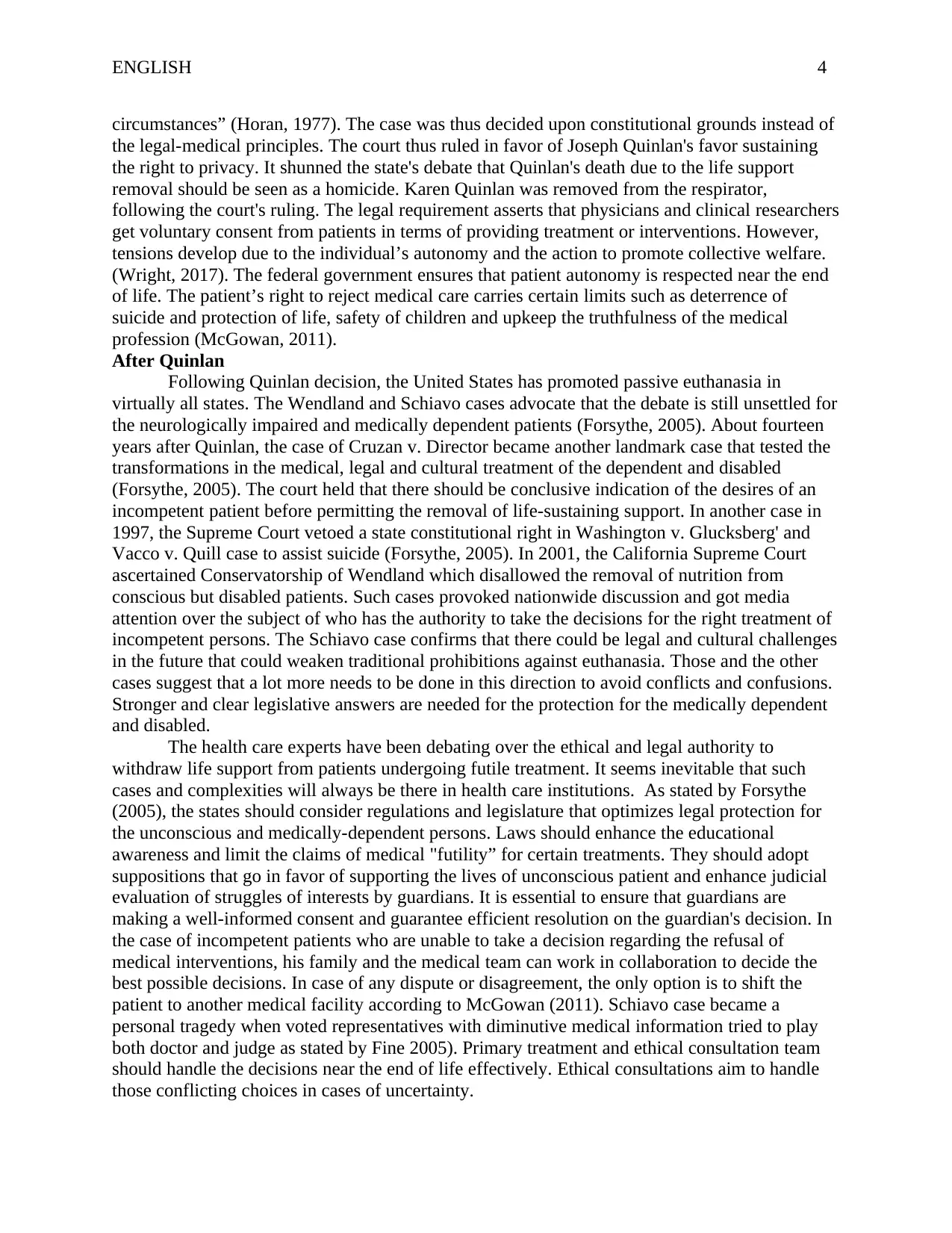
ENGLISH 4
circumstances” (Horan, 1977). The case was thus decided upon constitutional grounds instead of
the legal-medical principles. The court thus ruled in favor of Joseph Quinlan's favor sustaining
the right to privacy. It shunned the state's debate that Quinlan's death due to the life support
removal should be seen as a homicide. Karen Quinlan was removed from the respirator,
following the court's ruling. The legal requirement asserts that physicians and clinical researchers
get voluntary consent from patients in terms of providing treatment or interventions. However,
tensions develop due to the individual’s autonomy and the action to promote collective welfare.
(Wright, 2017). The federal government ensures that patient autonomy is respected near the end
of life. The patient’s right to reject medical care carries certain limits such as deterrence of
suicide and protection of life, safety of children and upkeep the truthfulness of the medical
profession (McGowan, 2011).
After Quinlan
Following Quinlan decision, the United States has promoted passive euthanasia in
virtually all states. The Wendland and Schiavo cases advocate that the debate is still unsettled for
the neurologically impaired and medically dependent patients (Forsythe, 2005). About fourteen
years after Quinlan, the case of Cruzan v. Director became another landmark case that tested the
transformations in the medical, legal and cultural treatment of the dependent and disabled
(Forsythe, 2005). The court held that there should be conclusive indication of the desires of an
incompetent patient before permitting the removal of life-sustaining support. In another case in
1997, the Supreme Court vetoed a state constitutional right in Washington v. Glucksberg' and
Vacco v. Quill case to assist suicide (Forsythe, 2005). In 2001, the California Supreme Court
ascertained Conservatorship of Wendland which disallowed the removal of nutrition from
conscious but disabled patients. Such cases provoked nationwide discussion and got media
attention over the subject of who has the authority to take the decisions for the right treatment of
incompetent persons. The Schiavo case confirms that there could be legal and cultural challenges
in the future that could weaken traditional prohibitions against euthanasia. Those and the other
cases suggest that a lot more needs to be done in this direction to avoid conflicts and confusions.
Stronger and clear legislative answers are needed for the protection for the medically dependent
and disabled.
The health care experts have been debating over the ethical and legal authority to
withdraw life support from patients undergoing futile treatment. It seems inevitable that such
cases and complexities will always be there in health care institutions. As stated by Forsythe
(2005), the states should consider regulations and legislature that optimizes legal protection for
the unconscious and medically-dependent persons. Laws should enhance the educational
awareness and limit the claims of medical "futility” for certain treatments. They should adopt
suppositions that go in favor of supporting the lives of unconscious patient and enhance judicial
evaluation of struggles of interests by guardians. It is essential to ensure that guardians are
making a well-informed consent and guarantee efficient resolution on the guardian's decision. In
the case of incompetent patients who are unable to take a decision regarding the refusal of
medical interventions, his family and the medical team can work in collaboration to decide the
best possible decisions. In case of any dispute or disagreement, the only option is to shift the
patient to another medical facility according to McGowan (2011). Schiavo case became a
personal tragedy when voted representatives with diminutive medical information tried to play
both doctor and judge as stated by Fine 2005). Primary treatment and ethical consultation team
should handle the decisions near the end of life effectively. Ethical consultations aim to handle
those conflicting choices in cases of uncertainty.
circumstances” (Horan, 1977). The case was thus decided upon constitutional grounds instead of
the legal-medical principles. The court thus ruled in favor of Joseph Quinlan's favor sustaining
the right to privacy. It shunned the state's debate that Quinlan's death due to the life support
removal should be seen as a homicide. Karen Quinlan was removed from the respirator,
following the court's ruling. The legal requirement asserts that physicians and clinical researchers
get voluntary consent from patients in terms of providing treatment or interventions. However,
tensions develop due to the individual’s autonomy and the action to promote collective welfare.
(Wright, 2017). The federal government ensures that patient autonomy is respected near the end
of life. The patient’s right to reject medical care carries certain limits such as deterrence of
suicide and protection of life, safety of children and upkeep the truthfulness of the medical
profession (McGowan, 2011).
After Quinlan
Following Quinlan decision, the United States has promoted passive euthanasia in
virtually all states. The Wendland and Schiavo cases advocate that the debate is still unsettled for
the neurologically impaired and medically dependent patients (Forsythe, 2005). About fourteen
years after Quinlan, the case of Cruzan v. Director became another landmark case that tested the
transformations in the medical, legal and cultural treatment of the dependent and disabled
(Forsythe, 2005). The court held that there should be conclusive indication of the desires of an
incompetent patient before permitting the removal of life-sustaining support. In another case in
1997, the Supreme Court vetoed a state constitutional right in Washington v. Glucksberg' and
Vacco v. Quill case to assist suicide (Forsythe, 2005). In 2001, the California Supreme Court
ascertained Conservatorship of Wendland which disallowed the removal of nutrition from
conscious but disabled patients. Such cases provoked nationwide discussion and got media
attention over the subject of who has the authority to take the decisions for the right treatment of
incompetent persons. The Schiavo case confirms that there could be legal and cultural challenges
in the future that could weaken traditional prohibitions against euthanasia. Those and the other
cases suggest that a lot more needs to be done in this direction to avoid conflicts and confusions.
Stronger and clear legislative answers are needed for the protection for the medically dependent
and disabled.
The health care experts have been debating over the ethical and legal authority to
withdraw life support from patients undergoing futile treatment. It seems inevitable that such
cases and complexities will always be there in health care institutions. As stated by Forsythe
(2005), the states should consider regulations and legislature that optimizes legal protection for
the unconscious and medically-dependent persons. Laws should enhance the educational
awareness and limit the claims of medical "futility” for certain treatments. They should adopt
suppositions that go in favor of supporting the lives of unconscious patient and enhance judicial
evaluation of struggles of interests by guardians. It is essential to ensure that guardians are
making a well-informed consent and guarantee efficient resolution on the guardian's decision. In
the case of incompetent patients who are unable to take a decision regarding the refusal of
medical interventions, his family and the medical team can work in collaboration to decide the
best possible decisions. In case of any dispute or disagreement, the only option is to shift the
patient to another medical facility according to McGowan (2011). Schiavo case became a
personal tragedy when voted representatives with diminutive medical information tried to play
both doctor and judge as stated by Fine 2005). Primary treatment and ethical consultation team
should handle the decisions near the end of life effectively. Ethical consultations aim to handle
those conflicting choices in cases of uncertainty.
Paraphrase This Document
Need a fresh take? Get an instant paraphrase of this document with our AI Paraphraser
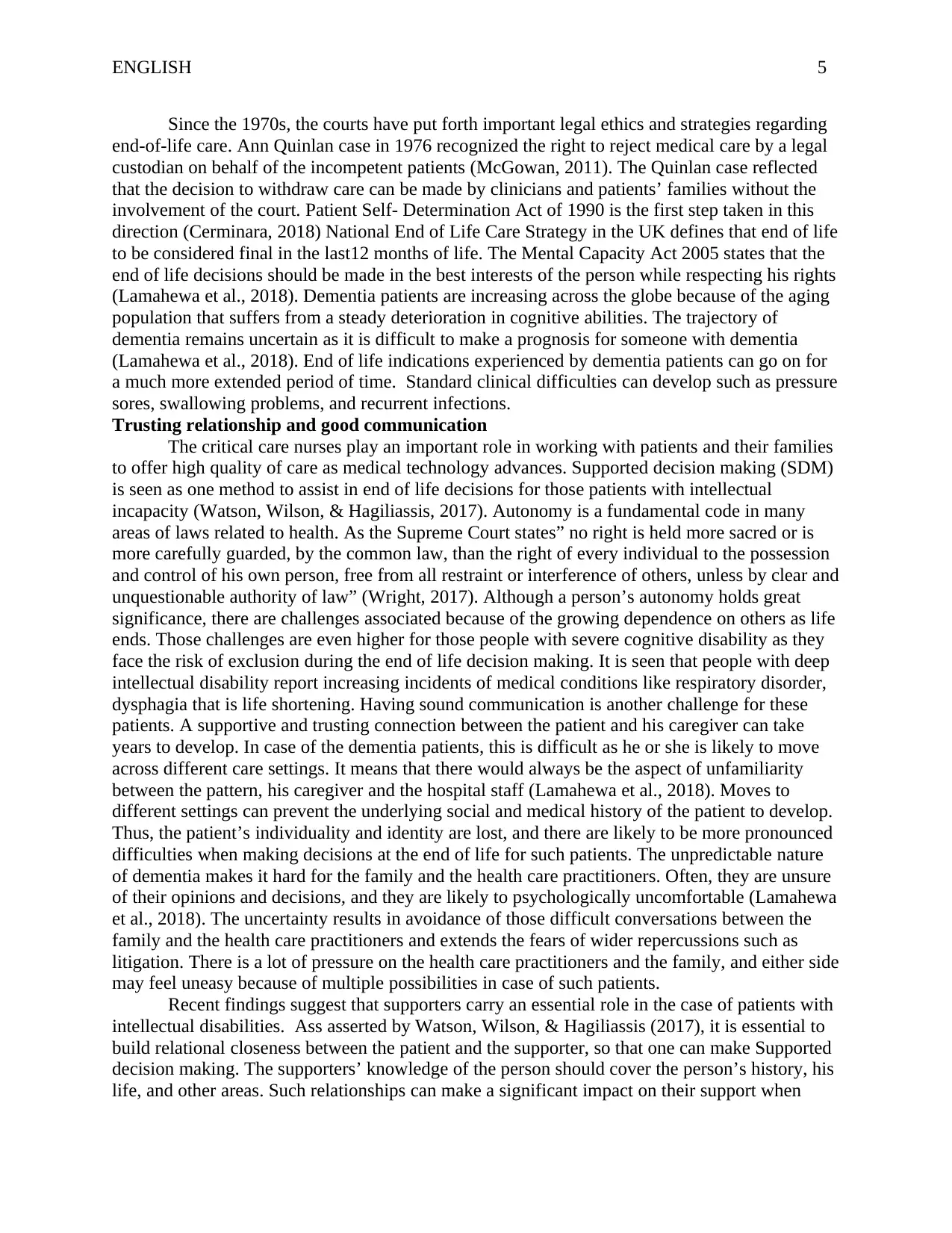
ENGLISH 5
Since the 1970s, the courts have put forth important legal ethics and strategies regarding
end-of-life care. Ann Quinlan case in 1976 recognized the right to reject medical care by a legal
custodian on behalf of the incompetent patients (McGowan, 2011). The Quinlan case reflected
that the decision to withdraw care can be made by clinicians and patients’ families without the
involvement of the court. Patient Self- Determination Act of 1990 is the first step taken in this
direction (Cerminara, 2018) National End of Life Care Strategy in the UK defines that end of life
to be considered final in the last12 months of life. The Mental Capacity Act 2005 states that the
end of life decisions should be made in the best interests of the person while respecting his rights
(Lamahewa et al., 2018). Dementia patients are increasing across the globe because of the aging
population that suffers from a steady deterioration in cognitive abilities. The trajectory of
dementia remains uncertain as it is difficult to make a prognosis for someone with dementia
(Lamahewa et al., 2018). End of life indications experienced by dementia patients can go on for
a much more extended period of time. Standard clinical difficulties can develop such as pressure
sores, swallowing problems, and recurrent infections.
Trusting relationship and good communication
The critical care nurses play an important role in working with patients and their families
to offer high quality of care as medical technology advances. Supported decision making (SDM)
is seen as one method to assist in end of life decisions for those patients with intellectual
incapacity (Watson, Wilson, & Hagiliassis, 2017). Autonomy is a fundamental code in many
areas of laws related to health. As the Supreme Court states” no right is held more sacred or is
more carefully guarded, by the common law, than the right of every individual to the possession
and control of his own person, free from all restraint or interference of others, unless by clear and
unquestionable authority of law” (Wright, 2017). Although a person’s autonomy holds great
significance, there are challenges associated because of the growing dependence on others as life
ends. Those challenges are even higher for those people with severe cognitive disability as they
face the risk of exclusion during the end of life decision making. It is seen that people with deep
intellectual disability report increasing incidents of medical conditions like respiratory disorder,
dysphagia that is life shortening. Having sound communication is another challenge for these
patients. A supportive and trusting connection between the patient and his caregiver can take
years to develop. In case of the dementia patients, this is difficult as he or she is likely to move
across different care settings. It means that there would always be the aspect of unfamiliarity
between the pattern, his caregiver and the hospital staff (Lamahewa et al., 2018). Moves to
different settings can prevent the underlying social and medical history of the patient to develop.
Thus, the patient’s individuality and identity are lost, and there are likely to be more pronounced
difficulties when making decisions at the end of life for such patients. The unpredictable nature
of dementia makes it hard for the family and the health care practitioners. Often, they are unsure
of their opinions and decisions, and they are likely to psychologically uncomfortable (Lamahewa
et al., 2018). The uncertainty results in avoidance of those difficult conversations between the
family and the health care practitioners and extends the fears of wider repercussions such as
litigation. There is a lot of pressure on the health care practitioners and the family, and either side
may feel uneasy because of multiple possibilities in case of such patients.
Recent findings suggest that supporters carry an essential role in the case of patients with
intellectual disabilities. Ass asserted by Watson, Wilson, & Hagiliassis (2017), it is essential to
build relational closeness between the patient and the supporter, so that one can make Supported
decision making. The supporters’ knowledge of the person should cover the person’s history, his
life, and other areas. Such relationships can make a significant impact on their support when
Since the 1970s, the courts have put forth important legal ethics and strategies regarding
end-of-life care. Ann Quinlan case in 1976 recognized the right to reject medical care by a legal
custodian on behalf of the incompetent patients (McGowan, 2011). The Quinlan case reflected
that the decision to withdraw care can be made by clinicians and patients’ families without the
involvement of the court. Patient Self- Determination Act of 1990 is the first step taken in this
direction (Cerminara, 2018) National End of Life Care Strategy in the UK defines that end of life
to be considered final in the last12 months of life. The Mental Capacity Act 2005 states that the
end of life decisions should be made in the best interests of the person while respecting his rights
(Lamahewa et al., 2018). Dementia patients are increasing across the globe because of the aging
population that suffers from a steady deterioration in cognitive abilities. The trajectory of
dementia remains uncertain as it is difficult to make a prognosis for someone with dementia
(Lamahewa et al., 2018). End of life indications experienced by dementia patients can go on for
a much more extended period of time. Standard clinical difficulties can develop such as pressure
sores, swallowing problems, and recurrent infections.
Trusting relationship and good communication
The critical care nurses play an important role in working with patients and their families
to offer high quality of care as medical technology advances. Supported decision making (SDM)
is seen as one method to assist in end of life decisions for those patients with intellectual
incapacity (Watson, Wilson, & Hagiliassis, 2017). Autonomy is a fundamental code in many
areas of laws related to health. As the Supreme Court states” no right is held more sacred or is
more carefully guarded, by the common law, than the right of every individual to the possession
and control of his own person, free from all restraint or interference of others, unless by clear and
unquestionable authority of law” (Wright, 2017). Although a person’s autonomy holds great
significance, there are challenges associated because of the growing dependence on others as life
ends. Those challenges are even higher for those people with severe cognitive disability as they
face the risk of exclusion during the end of life decision making. It is seen that people with deep
intellectual disability report increasing incidents of medical conditions like respiratory disorder,
dysphagia that is life shortening. Having sound communication is another challenge for these
patients. A supportive and trusting connection between the patient and his caregiver can take
years to develop. In case of the dementia patients, this is difficult as he or she is likely to move
across different care settings. It means that there would always be the aspect of unfamiliarity
between the pattern, his caregiver and the hospital staff (Lamahewa et al., 2018). Moves to
different settings can prevent the underlying social and medical history of the patient to develop.
Thus, the patient’s individuality and identity are lost, and there are likely to be more pronounced
difficulties when making decisions at the end of life for such patients. The unpredictable nature
of dementia makes it hard for the family and the health care practitioners. Often, they are unsure
of their opinions and decisions, and they are likely to psychologically uncomfortable (Lamahewa
et al., 2018). The uncertainty results in avoidance of those difficult conversations between the
family and the health care practitioners and extends the fears of wider repercussions such as
litigation. There is a lot of pressure on the health care practitioners and the family, and either side
may feel uneasy because of multiple possibilities in case of such patients.
Recent findings suggest that supporters carry an essential role in the case of patients with
intellectual disabilities. Ass asserted by Watson, Wilson, & Hagiliassis (2017), it is essential to
build relational closeness between the patient and the supporter, so that one can make Supported
decision making. The supporters’ knowledge of the person should cover the person’s history, his
life, and other areas. Such relationships can make a significant impact on their support when
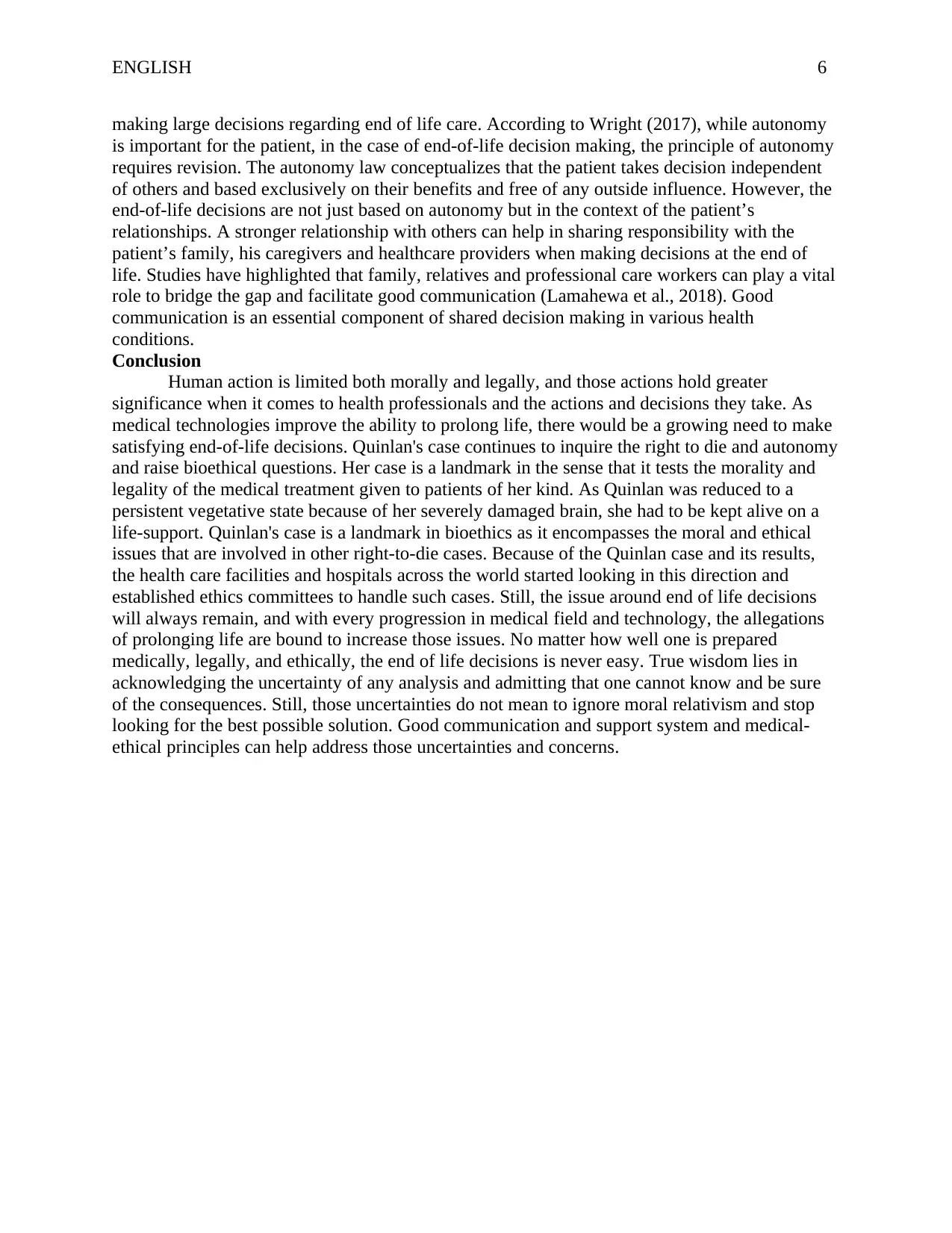
ENGLISH 6
making large decisions regarding end of life care. According to Wright (2017), while autonomy
is important for the patient, in the case of end-of-life decision making, the principle of autonomy
requires revision. The autonomy law conceptualizes that the patient takes decision independent
of others and based exclusively on their benefits and free of any outside influence. However, the
end-of-life decisions are not just based on autonomy but in the context of the patient’s
relationships. A stronger relationship with others can help in sharing responsibility with the
patient’s family, his caregivers and healthcare providers when making decisions at the end of
life. Studies have highlighted that family, relatives and professional care workers can play a vital
role to bridge the gap and facilitate good communication (Lamahewa et al., 2018). Good
communication is an essential component of shared decision making in various health
conditions.
Conclusion
Human action is limited both morally and legally, and those actions hold greater
significance when it comes to health professionals and the actions and decisions they take. As
medical technologies improve the ability to prolong life, there would be a growing need to make
satisfying end-of-life decisions. Quinlan's case continues to inquire the right to die and autonomy
and raise bioethical questions. Her case is a landmark in the sense that it tests the morality and
legality of the medical treatment given to patients of her kind. As Quinlan was reduced to a
persistent vegetative state because of her severely damaged brain, she had to be kept alive on a
life-support. Quinlan's case is a landmark in bioethics as it encompasses the moral and ethical
issues that are involved in other right-to-die cases. Because of the Quinlan case and its results,
the health care facilities and hospitals across the world started looking in this direction and
established ethics committees to handle such cases. Still, the issue around end of life decisions
will always remain, and with every progression in medical field and technology, the allegations
of prolonging life are bound to increase those issues. No matter how well one is prepared
medically, legally, and ethically, the end of life decisions is never easy. True wisdom lies in
acknowledging the uncertainty of any analysis and admitting that one cannot know and be sure
of the consequences. Still, those uncertainties do not mean to ignore moral relativism and stop
looking for the best possible solution. Good communication and support system and medical-
ethical principles can help address those uncertainties and concerns.
making large decisions regarding end of life care. According to Wright (2017), while autonomy
is important for the patient, in the case of end-of-life decision making, the principle of autonomy
requires revision. The autonomy law conceptualizes that the patient takes decision independent
of others and based exclusively on their benefits and free of any outside influence. However, the
end-of-life decisions are not just based on autonomy but in the context of the patient’s
relationships. A stronger relationship with others can help in sharing responsibility with the
patient’s family, his caregivers and healthcare providers when making decisions at the end of
life. Studies have highlighted that family, relatives and professional care workers can play a vital
role to bridge the gap and facilitate good communication (Lamahewa et al., 2018). Good
communication is an essential component of shared decision making in various health
conditions.
Conclusion
Human action is limited both morally and legally, and those actions hold greater
significance when it comes to health professionals and the actions and decisions they take. As
medical technologies improve the ability to prolong life, there would be a growing need to make
satisfying end-of-life decisions. Quinlan's case continues to inquire the right to die and autonomy
and raise bioethical questions. Her case is a landmark in the sense that it tests the morality and
legality of the medical treatment given to patients of her kind. As Quinlan was reduced to a
persistent vegetative state because of her severely damaged brain, she had to be kept alive on a
life-support. Quinlan's case is a landmark in bioethics as it encompasses the moral and ethical
issues that are involved in other right-to-die cases. Because of the Quinlan case and its results,
the health care facilities and hospitals across the world started looking in this direction and
established ethics committees to handle such cases. Still, the issue around end of life decisions
will always remain, and with every progression in medical field and technology, the allegations
of prolonging life are bound to increase those issues. No matter how well one is prepared
medically, legally, and ethically, the end of life decisions is never easy. True wisdom lies in
acknowledging the uncertainty of any analysis and admitting that one cannot know and be sure
of the consequences. Still, those uncertainties do not mean to ignore moral relativism and stop
looking for the best possible solution. Good communication and support system and medical-
ethical principles can help address those uncertainties and concerns.
⊘ This is a preview!⊘
Do you want full access?
Subscribe today to unlock all pages.

Trusted by 1+ million students worldwide
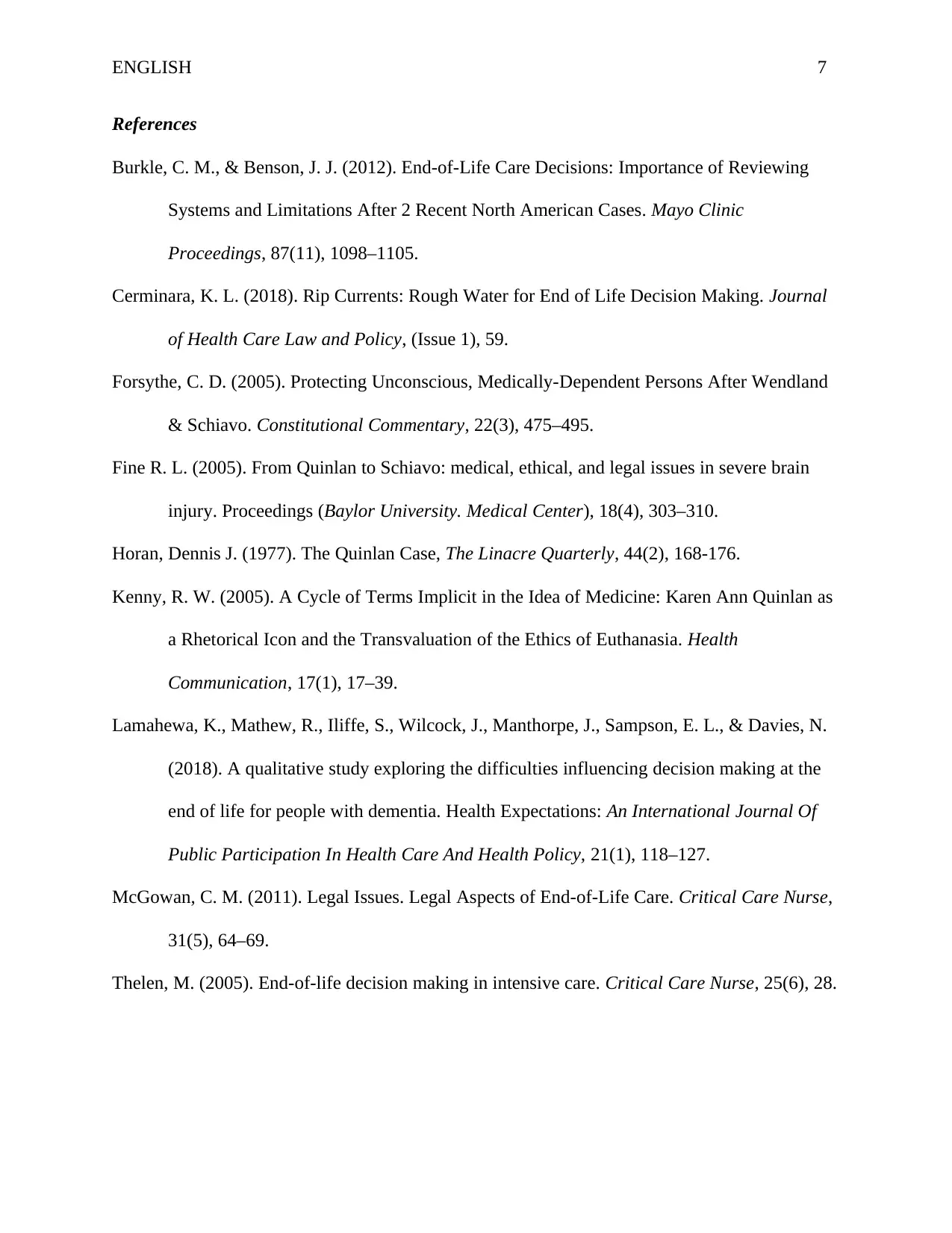
ENGLISH 7
References
Burkle, C. M., & Benson, J. J. (2012). End-of-Life Care Decisions: Importance of Reviewing
Systems and Limitations After 2 Recent North American Cases. Mayo Clinic
Proceedings, 87(11), 1098–1105.
Cerminara, K. L. (2018). Rip Currents: Rough Water for End of Life Decision Making. Journal
of Health Care Law and Policy, (Issue 1), 59.
Forsythe, C. D. (2005). Protecting Unconscious, Medically-Dependent Persons After Wendland
& Schiavo. Constitutional Commentary, 22(3), 475–495.
Fine R. L. (2005). From Quinlan to Schiavo: medical, ethical, and legal issues in severe brain
injury. Proceedings (Baylor University. Medical Center), 18(4), 303–310.
Horan, Dennis J. (1977). The Quinlan Case, The Linacre Quarterly, 44(2), 168-176.
Kenny, R. W. (2005). A Cycle of Terms Implicit in the Idea of Medicine: Karen Ann Quinlan as
a Rhetorical Icon and the Transvaluation of the Ethics of Euthanasia. Health
Communication, 17(1), 17–39.
Lamahewa, K., Mathew, R., Iliffe, S., Wilcock, J., Manthorpe, J., Sampson, E. L., & Davies, N.
(2018). A qualitative study exploring the difficulties influencing decision making at the
end of life for people with dementia. Health Expectations: An International Journal Of
Public Participation In Health Care And Health Policy, 21(1), 118–127.
McGowan, C. M. (2011). Legal Issues. Legal Aspects of End-of-Life Care. Critical Care Nurse,
31(5), 64–69.
Thelen, M. (2005). End-of-life decision making in intensive care. Critical Care Nurse, 25(6), 28.
References
Burkle, C. M., & Benson, J. J. (2012). End-of-Life Care Decisions: Importance of Reviewing
Systems and Limitations After 2 Recent North American Cases. Mayo Clinic
Proceedings, 87(11), 1098–1105.
Cerminara, K. L. (2018). Rip Currents: Rough Water for End of Life Decision Making. Journal
of Health Care Law and Policy, (Issue 1), 59.
Forsythe, C. D. (2005). Protecting Unconscious, Medically-Dependent Persons After Wendland
& Schiavo. Constitutional Commentary, 22(3), 475–495.
Fine R. L. (2005). From Quinlan to Schiavo: medical, ethical, and legal issues in severe brain
injury. Proceedings (Baylor University. Medical Center), 18(4), 303–310.
Horan, Dennis J. (1977). The Quinlan Case, The Linacre Quarterly, 44(2), 168-176.
Kenny, R. W. (2005). A Cycle of Terms Implicit in the Idea of Medicine: Karen Ann Quinlan as
a Rhetorical Icon and the Transvaluation of the Ethics of Euthanasia. Health
Communication, 17(1), 17–39.
Lamahewa, K., Mathew, R., Iliffe, S., Wilcock, J., Manthorpe, J., Sampson, E. L., & Davies, N.
(2018). A qualitative study exploring the difficulties influencing decision making at the
end of life for people with dementia. Health Expectations: An International Journal Of
Public Participation In Health Care And Health Policy, 21(1), 118–127.
McGowan, C. M. (2011). Legal Issues. Legal Aspects of End-of-Life Care. Critical Care Nurse,
31(5), 64–69.
Thelen, M. (2005). End-of-life decision making in intensive care. Critical Care Nurse, 25(6), 28.
Paraphrase This Document
Need a fresh take? Get an instant paraphrase of this document with our AI Paraphraser
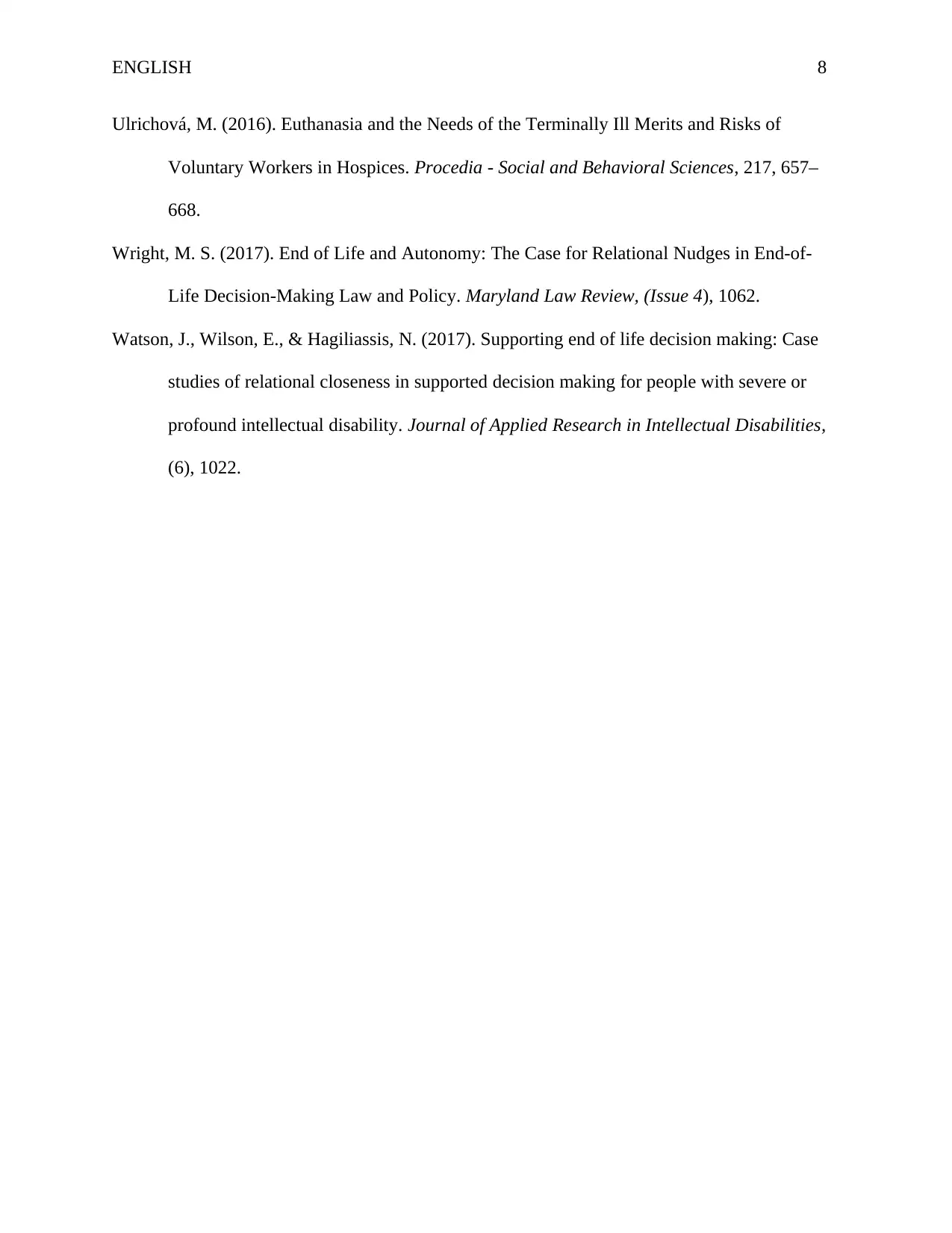
ENGLISH 8
Ulrichová, M. (2016). Euthanasia and the Needs of the Terminally Ill Merits and Risks of
Voluntary Workers in Hospices. Procedia - Social and Behavioral Sciences, 217, 657–
668.
Wright, M. S. (2017). End of Life and Autonomy: The Case for Relational Nudges in End-of-
Life Decision-Making Law and Policy. Maryland Law Review, (Issue 4), 1062.
Watson, J., Wilson, E., & Hagiliassis, N. (2017). Supporting end of life decision making: Case
studies of relational closeness in supported decision making for people with severe or
profound intellectual disability. Journal of Applied Research in Intellectual Disabilities,
(6), 1022.
Ulrichová, M. (2016). Euthanasia and the Needs of the Terminally Ill Merits and Risks of
Voluntary Workers in Hospices. Procedia - Social and Behavioral Sciences, 217, 657–
668.
Wright, M. S. (2017). End of Life and Autonomy: The Case for Relational Nudges in End-of-
Life Decision-Making Law and Policy. Maryland Law Review, (Issue 4), 1062.
Watson, J., Wilson, E., & Hagiliassis, N. (2017). Supporting end of life decision making: Case
studies of relational closeness in supported decision making for people with severe or
profound intellectual disability. Journal of Applied Research in Intellectual Disabilities,
(6), 1022.
1 out of 8
Related Documents
Your All-in-One AI-Powered Toolkit for Academic Success.
+13062052269
info@desklib.com
Available 24*7 on WhatsApp / Email
![[object Object]](/_next/static/media/star-bottom.7253800d.svg)
Unlock your academic potential
Copyright © 2020–2025 A2Z Services. All Rights Reserved. Developed and managed by ZUCOL.




